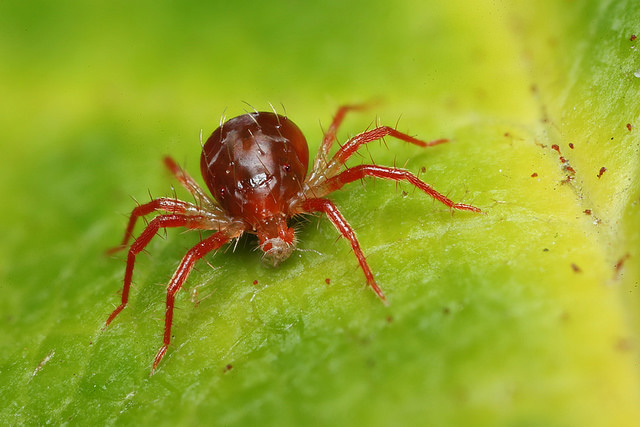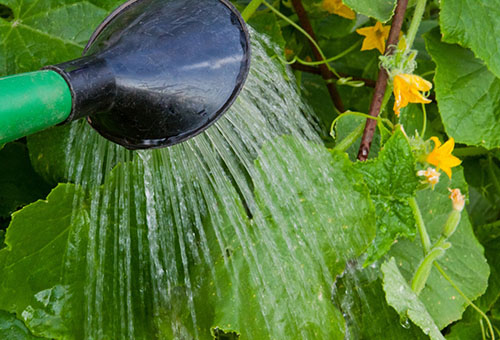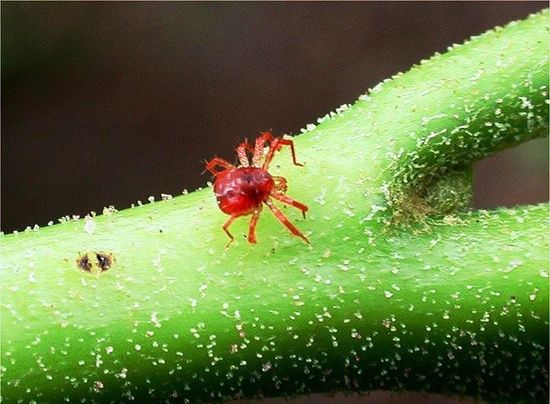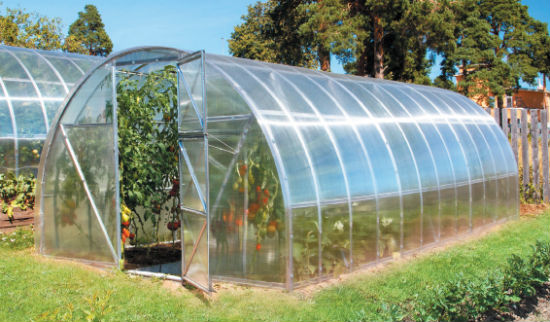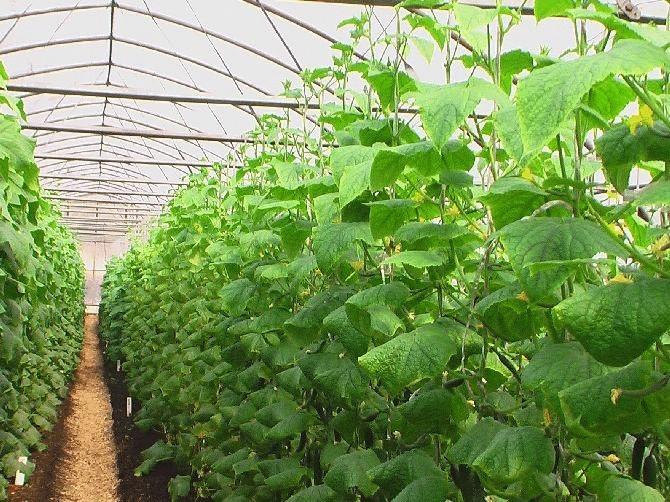How and what to treat a greenhouse from a spider mite
Content
Why is the spider mite dangerous?
The spider mite is a small pest 0.3 - 2 mm in size, which infects the leaves of vegetable crops and feeds on the extracted juice. Externally, it is not difficult to determine the reproduction of a tick in a greenhouse - you will see small white dots on the surface of the leaves, which eventually become large necrotic spots. The tick is dangerous because it attacks plants in a short time, which soon wither and die. Part of plant cells is destroyed, the area and rate of photosynthesis decreases, the culture weakens, becomes susceptible to infection.
The spider mite is also a carrier of many dangerous infections. It spreads gray mold spores, viral infections of agricultural and ornamental crops. Spider mites multiply at an astonishing rate inside the greenhouse. A female tick can lay a huge number of eggs in one clutch - up to 400 eggs. And there are about 20 such clutches per season. Females calmly endure even the coldest winters. Tick eggs have a high viability - up to 5 years.
How to fight
Many gardeners are interested in the question - how to deal with a spider mite? This is quite difficult, since many of the control measures used to kill other insects are ineffective against the tick. The mite is not afraid of spraying with water, exposure to ultraviolet radiation, laundry soap, onion and garlic peels. Experts identify a number of measures that will help to combat a dangerous pest.
It is recommended to alternate the planting of cucumbers with tomatoes in order to avoid the rapid spread of the pest. On tomatoes, the mite is harder to reproduce. Weeds must be removed from the greenhouse in a timely manner, it is on them that the tick prefers to spend the winter period. The greenhouse should be properly cared for to create an unfavorable microclimate for ticks. Adhere to accepted agricultural practices for vegetable crops.
The distance between plants must be at least 1 meter. So it will be difficult for insects to move. Row spacings are advised to be wide enough - this will help get rid of foci of infection before they spread. The moisture index for cucumbers should be at the level of 80 - 85% or more. It is necessary to carry out regular watering of vegetables, mulching and loosening the soil. A close inspection of the greenhouse every few days will help detect pests and take action quickly. Pest control consists of spraying with drugs, which should be done every couple of weeks. Spraying is permissible more often if the spider mite was able to settle throughout the greenhouse.
During the growing season, processing is carried out once a week. Colloidal sulfur is effective at the rate of 80 grams per bucket of water, fitoverm - 10 ml per bucket, bitoxibacillin - 100 grams per bucket.Ground sulfur gives the result when pollinated with 4 grams of product per square meter of area. Leaves with the enemy of the tick, which is the predatory mite phytoseiulus, can be spread around the infected plant. If the above methods do not help in the fight, use chemicals with toxic properties.
What harm is done to the greenhouse
A spider mite is able to settle in a glass, polycarbonate greenhouse, a thermos greenhouse and other similar types of structures. Its undesirable settlement is associated with increased requirements for the microclimate of the greenhouse when growing various crops. The reasons for the appearance of a spider mite are called non-compliance with the temperature regime, excessive humidity, plant residues in the fall, weeds, contaminated fertilizers and soil.
The parasite can get inside the greenhouse along with the seedlings, on animals or on people's clothes. It is completely impossible to avoid its penetration into the greenhouse. If you do not start to fight the tick in time, then the whole greenhouse will soon be under threat. If, at the end of the last harvest, the plants are treated with modern acaricides, then this will become an obstacle to the dispersal of arachnids throughout the greenhouse.
Video "How to get rid of a tick"
Preparations for the fight
High-quality drugs that can be purchased in specialized stores help fight the pest. The effectiveness of such a fight depends on the degree of damage to the greenhouse. Plant-Pin tool allows you to get rid of insects in a short time. It is offered in a convenient form of sticks that are dipped into the ground near the stem. When watering, the drug dissolves and has a detrimental effect on parasites. Initially, the product was produced for the care of indoor plants. The direct impact on the pest begins 2 to 3 days after treatment. The drug continues to protect vegetable crops after a month and a half after the start of use.
Actellic is a product that should be used with rubber gloves and a cotton-gauze bandage. The ampoule should be opened and the contents poured into one and a half liters of water. After mixing, the solution can be used. It is placed in a spray bottle and the leaves are sprayed. When working with Aktellik, you cannot do without precautions, since the drug has a strong effect. Akarin - has a gastrointestinal effect, which manifests itself, getting into the digestive tract of parasites. After spraying, it remains effective for 4 - 8 hours. Vegetable crops are unsafe for humans for 3 to 4 days.
Apollo - affects the larvae and eggs of insects, produces sterilization of adults. It is active for a week after spraying the plants. Etisso is a drug similar in effect to Plant-Pin. The difference lies in the main active ingredient - in Plant-Pin it is butoxyraboxim, in Etisso - dimethoate. This insecticide is organophosphate and dissolves from the stick in the process of watering the plants.
Fitoverm - parasites can quickly become addicted to the drug, so you need to strictly follow the instructions. Low toxicity for humans and animals is a plant-based drug. If, upon detecting the first signs of insect infestation of vegetable crops, spraying with the agent in the recommended dosage, then you can count on a positive result as soon as possible.
Other modern drugs - BI-58, Vermitek, Aktofit, Flumite - will also help to fight a dangerous pest. The Anti-mite preparation has proven itself well - it has an acceptable cost and can be used in greenhouses. When carrying out all manipulations, be extremely careful and use disposable gloves, which then need to be thrown away. Wash your hands thoroughly, as any of the above products is highly toxic and can harm human health.
Remember that the use of folk remedies is not for destruction, but for scaring away this type of pest.
Difficulties in removing spider mites
The spider mite causes a lot of trouble for greenhouse owners. In the process of destroying it, one has to face inevitable difficulties. It is not so easy to see parasites that have just appeared on vegetable crops, which also multiply too quickly. Insects can adapt to some modern drugs, and these tools will become ineffective helpers for you in killing pests. Since the females lay new eggs every day, the greenhouse owner will have to repeat the measures to eliminate the pest population several times.
Insects must be removed from the greenhouse completely, since the number of individuals is constantly increasing. Throughout the room, there is a large amount of cobwebs along which parasites move. The web has the ability to protect insects from moisture destructive for them and spraying with solutions. We will have to spend a lot of money on the purchase of modern drugs, as their large doses will be required. The use of highly concentrated products is dangerous to human health and can lead to infection of the fruits of plants growing in the greenhouse.
Video "Common spider mite"
What kind of parasite it is, how it can harm the yield of your greenhouse, you will learn from the video below.

